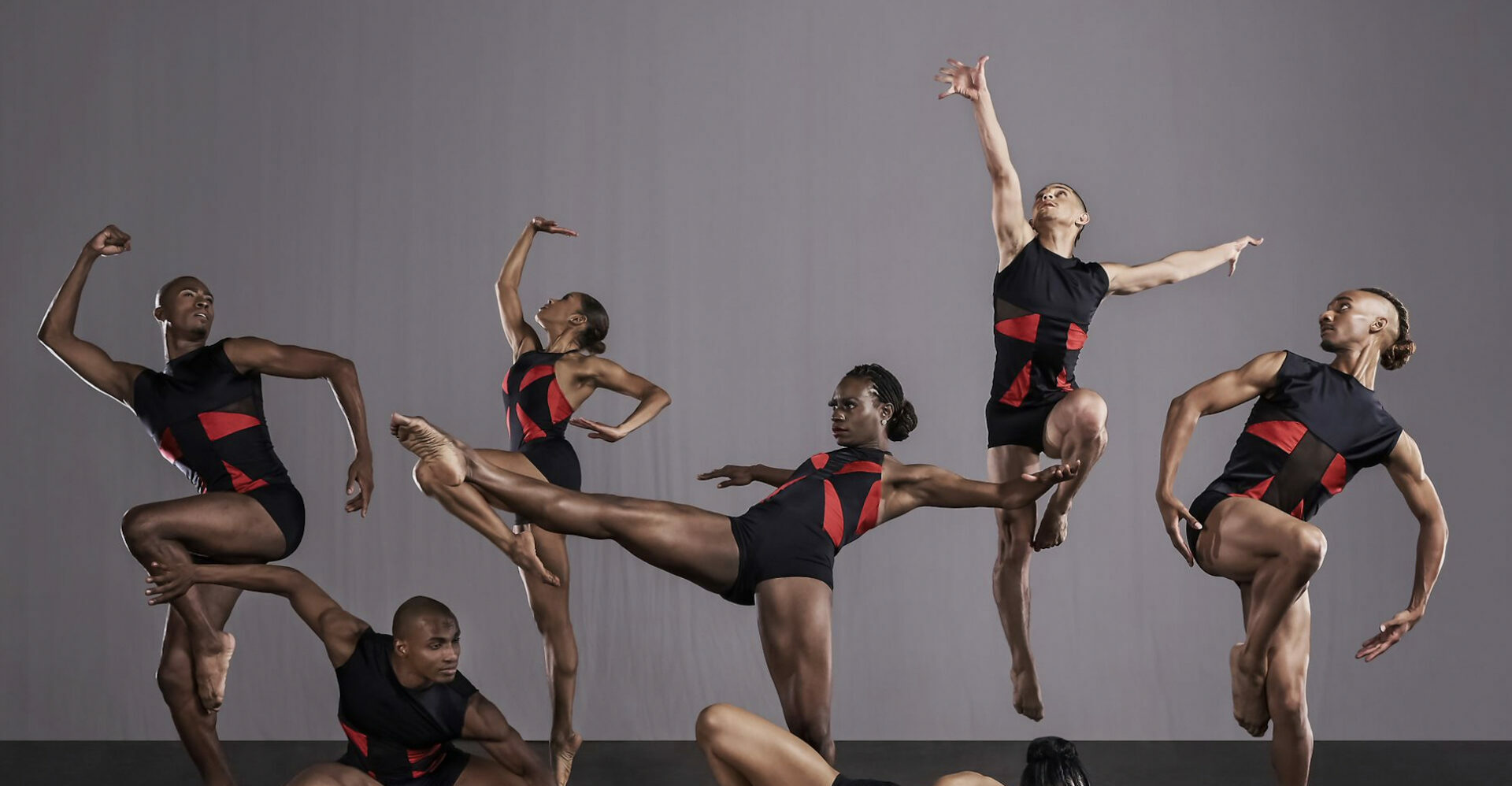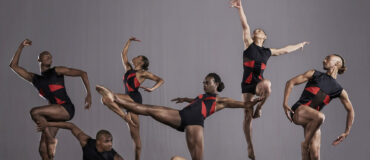Archiving Fellowships Blog: Jennifer Harge/Harge Dance Stories, Part 2
By Laila Franklin
Laila Franklin is a 2023 Archiving and Preservation Fellow with Jennifer Harge/Harge Dance Stories. Read more about the Fellowships here. This is the second part of Laila’s blog; read the first part here and the third part here.
A Conversation with Jennifer Harge
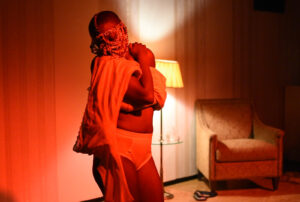
Photo Credit: Devin Drake – Pictured: Jennifer Harge in FLY | DROWN (Detroit Artist’s Market, 2019)
When approaching archival projects, contextualizing the work of the artist in question is paramount for creating archives that have both utility and approachability. Through this Dance/USA Fellowship, we sought to develop a method that honored the multidisciplinary form that Jennifer Harge’s work takes. This meant it was essential to have a working understanding of Harge’s creative practice and how it has led her to this specific moment. Throughout the process, I posed questions to Harge to more intimately understand her work and the ways that archiving could support it. My own approach to support was absolutely influenced by our archiving mentor, Marcia Black of Black Bottom Archives Detroit. Throughout our time working together she encouraged us to consider not just the practical utility of each step, but the larger desires we have for the project. In a very succinct way, she kept us on track, asking pointed questions and doling out instruction and advice that kept us moving in the right direction. Setting concrete goals for ourselves this summer, some of which prepared the project to propel into the future, allowed for efficient and effective work time. In addition to this approach, the intervention of collaborators assisted me greatly. Devin Drake and Miryam Johnson are both long-time collaborators of Harge and provided invaluable insight into not just the archival collection but the constellation of Harge’s work and creative practice. Their collective knowledge and resources on past projects and current work laid a clear pathway for the ways that archiving was already embedded into Harge’s practice and the ways that further solidifying, or formalizing, that practice could provide even greater support to future work.
The primary goal of this archive is to serve as a resource for a larger, long-term writing project. This would be the eventual public-facing product of our work together. However, the more time we spent with the archive during our second residency, the more we realized that we wanted some kind of intervention from the public at this stage of organization. To better understand and affirm the project, we sought to bring in a small group of community members to share our work with and take questions and reflections from. We decided to use that space of sharing as a moment to reflect on our process, bringing in more language to contextualize the project and Harge’s creative practice as a whole. I took time to craft a handful of guiding questions that would help distill the project background and the importance of this archival process. Following that sharing was an opportunity for community engagement, a chance to imagine the ways that this archive could act as support or influence to other folks’ creative practice. Below are the questions posed and excerpts of responses from that guided sharing.
Some quotes have been edited for clarity and brevity.
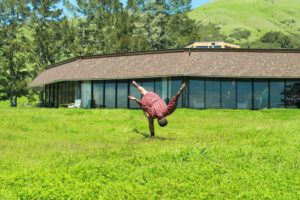
Photo Credit: Fred Tangerman – Pictured: Harge in residence at Djerassi Resident Artist’s Program, 2019
Laila Franklin: Could you provide a brief introduction to yourself and how you arrived at your current artistic practice? When did the papers become prominent in your practice? What attracted you to that material? Does the scale support your work in a particular way? How?
Jennifer Harge: I have been working with these rolls of butcher paper, which I’ve been using as a process for like five years. I’ve had a collection of them that I made when I was at a residency called Yaddo in 2021. And I just carried them around with me. Like they was in my closet [sic], and the papers themselves are a way for me to process information.
The first time I ever saw someone use large Post-it notes was at a sidewalk meeting, and I was like, oh, bigger paper. Something in my mind was like … That’s what I’ve been needing. So I was using big Post-it notes just to put ideas on the wall, just to see them and sit with them and let them kind of permeate the space in a way. And then, I did a residency in California and they had a tall standing roll of butcher paper that you could just come use whenever you need it and I was like, “butcher paper?” You just roll it out. It’s like a longer stream of thoughts could happen. So I’ve been using butcher paper to make dances basically for the last five years.
LF: Could you provide some background context on this collection, the Yaddo Papers? How does this particular collection tie into the larger scope of the arc of your work?
JH: In 2021, I went to Yaddo and it was the first time that I [didn’t have to make] a production thing on the other side [of the residency] because it was still in that pandemic moment of not having things on the other side. I walked in with a project and I got there and that felt really boring. So I was like: “I’m not going to do what I came with, what are you doing in the studio for a month?” I hadn’t had that practice as a dance person to come into a studio for myself. It was always to plan technique class or to plan a piece or something. It was always for a production. It allowed for me to have time to think about what my studio practice was for myself. In that I was able to be with all the things I love, like books. And it was a visual artist studio that had a sprung floor, so I could, like, draw on the walls. ‘Cause you know, in [a traditional dance studio] you can’t get the walls messed up. We could put pins through the wall, all these things kind of opened up. And so it gave me time to just process, just to be with my thinking and my creative, multi, omnidirectional way of being in creative practice, of spilling across forms. Dance is one of those forms. It doesn’t have to have a hierarchy in any kind of way.
So what is my practice, then, as a person who uses the body, but other things show up, and how do I let them? How do I understand when to shift? How do I listen for when to stay or linger longer?
LF: How is this archive supporting your practice? Short term? Long term? How has your notation approach informed the aesthetics and the overall utility of this working archive?
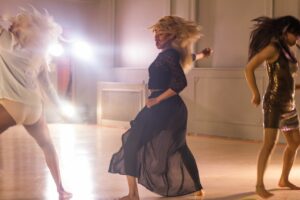
Photo Credit: Bree Gant – Pictured: Jennifer Harge, Amber Moore and Shanice Rollins in Harge’s the (her)stor(ies) project, 2018
JH: I knew for maybe a few years that I should organize this butcher paper. Number one, ‘cause I use Crayola markers. So that’s a really important material, but if one drop of water gets on them [they’re illegible]. So my first thought was just to organize them, [digitize them] in some way. Then the Dance USA Fellowship showed up and something about the word “archive.” I was like, “Oh, okay. I guess if we organize them that is, I guess, an archive.”
So Marcia Black is the archivist for Black Bottom Detroit’s archive, who is incredible. She came in and gave us some really practical archiving techniques, just to help give us a pathway of how to collect the data. [She would] also ask questions like: “What is the purpose of it? So it’s not just data collection for the sake of collecting things, but what is the utility? Who is it for? What’s the value system in here?” So being with these kinds of techniques, but also being with it as a value system, and as a creative practice, kind of shifted my understanding of what archiving can be.
My longtime collaborator, Miryam Johnson, came through one day and went through the papers as well and was able to connect them to past works I had made. I had been making this argument of, “This is the thing I did, I started at Yaddo in 2021.” I had made these maps and all this theory, and Miryam was able to be like, “Remember that one rehearsal in 2015?” [and I realized] “Oh, so this is like a continuation, a deepening of a thing, not a new thing.”
She was able to give it a foundation that I didn’t know really existed, [or rather] I kind of lost track of what had come before. So she was really able to help me remember what the lineage of the practice had been prior to Yaddo. So while Yaddo was able to help me talk about it outside of the context of a production or of particular pieces, these practices have been applied to the dances that have been, that had come before, but maybe didn’t have language. So that was super helpful and affirming.
Header image: Photo by Kirk Donaldson. Pictured: Jennifer Harge leading University of Michigan Dance students in Harge’s “Studio A, will you die with me?” (Ann Arbor, MI 2019)
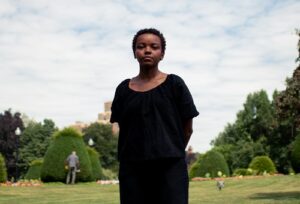 Laila J. Franklin (she/her) is a dance maker, performer, teacher, administrator, and writer based in the unceded territory of the Massachusett and Pawtucket peoples (Boston, Massachusetts.) Her work extends from lineages of Black queer experimental dance makers, with a particular interest in postmodern improvisatory practices and aesthetics, and dance theater. In her work, she explores kinetic imagination through the rigor of juxtaposing virtuosic and intimate performances, seeking to make legible the (in)visibility of lived experience. Her performance/collaboration credits include work with Miguel Gutierrez, Melinda Jean Myers, Dr. Christopher-Rasheem McMilland, and Ruckus Dance. As a Fellow, Laila is looking forward to collaborating with Jennifer Harge/Harge Dance Stories to explore ways to bring further legibility to an embodied and culturally citational body of work, taking experiential approaches to transfer bodily archives to physical archives. Laila holds an MFA in Dance from the University of Iowa and a BFA in Contemporary Dance Performance from The Boston Conservatory. Photo credit: Bailey Bailey.
Laila J. Franklin (she/her) is a dance maker, performer, teacher, administrator, and writer based in the unceded territory of the Massachusett and Pawtucket peoples (Boston, Massachusetts.) Her work extends from lineages of Black queer experimental dance makers, with a particular interest in postmodern improvisatory practices and aesthetics, and dance theater. In her work, she explores kinetic imagination through the rigor of juxtaposing virtuosic and intimate performances, seeking to make legible the (in)visibility of lived experience. Her performance/collaboration credits include work with Miguel Gutierrez, Melinda Jean Myers, Dr. Christopher-Rasheem McMilland, and Ruckus Dance. As a Fellow, Laila is looking forward to collaborating with Jennifer Harge/Harge Dance Stories to explore ways to bring further legibility to an embodied and culturally citational body of work, taking experiential approaches to transfer bodily archives to physical archives. Laila holds an MFA in Dance from the University of Iowa and a BFA in Contemporary Dance Performance from The Boston Conservatory. Photo credit: Bailey Bailey.
____
We accept submissions on topics relevant to the field: advocacy, artistic issues, arts policy, community building, development, employment, engagement, touring, and other topics that deal with the business of dance. We cannot publish criticism, single-company season announcements, and single-company or single artist profiles. Additionally, we welcome feedback on articles. If you have a topic that you would like to see addressed or feedback, please contact communications@danceusa.org.
Disclaimer: Opinions expressed in guest posts do not necessarily represent the viewpoints of Dance/USA.
